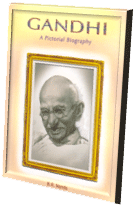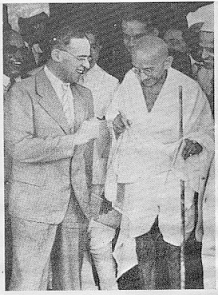
P.O. SEVAGRAM, DIST.WARDHA 442102, MS, INDIA. Phone: 91-7152-284753
FOUNDED BY MAHATMA GANDHI IN 1936
BIOGRAPHY OF GANDHI
GANDHI - A PICTORIAL BIOGRAPHY
by Shri B. R. Nanda

GANDHI
- A PICTORIAL BIOGRAPHY
Shri B. R. Nanda
Table of Contents
- About Gandhi
- Childhood
- Off To England
- Briefless Barrister
- In The 'Dark Continent'
- The Young Politician
- Satyagraha Struggle In South Africa
- The Making Of The Mahatma
- Return To India
- Gandhi's Ashram
- World War I
- Rowlatt Bills
- Nonviolent Non-cooperation
- Arrest And Imprisonment
- Reaction And Recovery
- Declaration Of Complete Independence
- Gandhi-Irwin Pact
- Round Table Conference
- In London
- Resumption Of Struggle
- Campaign Against Untouchability
- A New Deal For The Village
- The New Constitution
- Hindu-Muslim Antagonism
- Nonviolence In A Violent World
- Cripps Mission
- "Quit India"
- Simla Conference
- Cabinet Mission
- Communal Conflagration
- Partition of India
- Mission of Peace
- The End
- Gandhi and Nonviolence
About This Book
This is the first pictorial biography of Gandhi in which the narrative-concise, readable and incisive is illustrated with contemporary photographs and facsimiles of letters, newspaper reports and cartoons, adding up to a fascinating flash-back on the life of Mahatma Gandhi and the struggle for Indian freedom led by him. There is a skilful matching in this book of text and illustrations, of description and analysis and of concrete detail and large perspective. This pictorial biography will revive many memories in those who have lived through the Gandhian era; it should also be of interest to the post-independence generation.
About Author
Shri B. R. Nanda - former Director, Nehru Memorial Museum and Library, New Delhi. His full-scale biography of Mahatma Gandhi has been published in India, Britain and the U.S.A. and translated into French, Spanish, Italian and several other languages
Chapter-25 : Cripps Mission

Gandhi was thus firmly anchored to pacifism when the war broke out in 1939, but many of his closest colleagues and the rank and file in the Indian National Congress could not bring themselves to accept the feasibility of defending the country against aggression without resort to arms. Twice during the war - after the fall of France in 1940, and the collapse of the British position in South East Asia in 1941 - when there was a possibility of a rapprochement between the Congress and the Government for a united war effort, Gandhi stepped aside rather than be a party to organized violence. The rapprochement did not come. The only serious British effort for a compromise was made in the Spring of 1942 with the dispatch of the Cripps Mission to India; it proved abortive.
For nearly two and a half years, Gandhi had resisted pressure from a section of his following for the launching of a mass movement. It became clear that the British Government first under Chamberlain, and then under Churchill, was reluctant to assure Indian freedom in the future, or to offer a practical token of it in the present Gandhi had endeavoured to restrain the radical wing of the Congress party, and diverted its discontent into "individual Satyagraha", a subdued form of civil resistance confined to "selected individuals"
After the failure of the Cripps Mission, Gandhi noted with concern that in the face of grave peril posed by the Japanese advance in South East Asia, the mood of the people of India was not one of resolute defiance, but of panic, frustration and helplessness. If India was not to go the way of Malaya and Burma, something had to be done, and done quickly. He came to the conclusion that only an immediate declaration of Indian independence by the British Government could give the people of India a stake in the defence of their country.